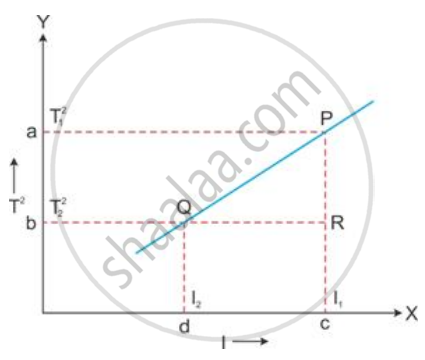Advertisements
Advertisements
प्रश्न
How does the time period (T) of a simple pendulum depend on its length (l)? Draw a graph showing the variation of T2 with l. How will you use this graph to determine the value of g (acceleration due to gravity)?
उत्तर
The time period of a simple pendulum is directly proportional to the square root of its effective length.
`T ∝ sqrt(l)`

From this graph, the value of acceleration due to gravity (g) can be calculated as follows.
The slope of the straight line can be found by taking two points P and Q on the straight line and drawing normals from these points on the X- and Y-axis, respectively. Then, the value of T2 is to be noted at a and b, the value of l at c and d. Then,
Slope = `"PR"/"QR" = "ab"/"cd" = (T_1^2 - T_2^2)/(l_1 - l_2)`
This slope is found to be constant at a place and is equal to `(4pi^2)/"g"` , where g is the acceleration due to gravity at that place. Thus, g can be determined at a place from these measurements using the following relation:
`"g" = (4pi^2)/("Slope" "of" T^2 "Vs" l "graph")`
APPEARS IN
संबंधित प्रश्न
A microscope has its main scale with 20 divisions in 1 cm and vernier scale with 25 divisions, the length of which is equal to the length of 24 divisions of main scale. The least count of microscope is
A vernier has 10 divisions and they are equal to 9 divisions of the main scale in length. If the main scale is calibrated in mm, what is its least count?
Define the term amplitude.
Define the term frequency.
A body measures 25 m. State the unit and the magnitude of the unit in the statement.
Name the most convenient unit of mass you will use to measure:
The grain output of a state
Explain the method in steps to find the volume of an irregular solid with the help of a measuring cylinder.
Amongst the unit of volume which is most suitable for measuring:
Volume of an exercise book
